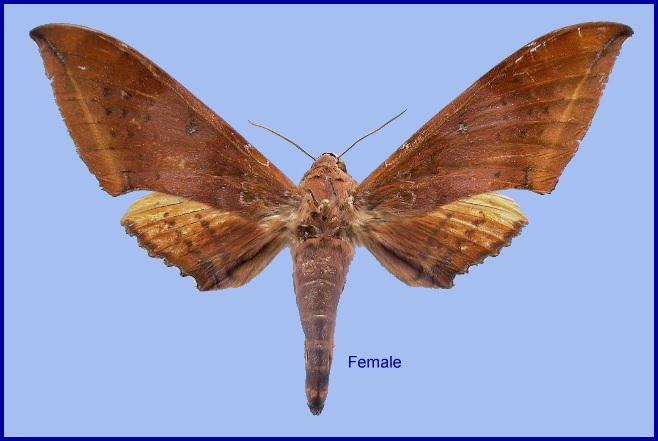
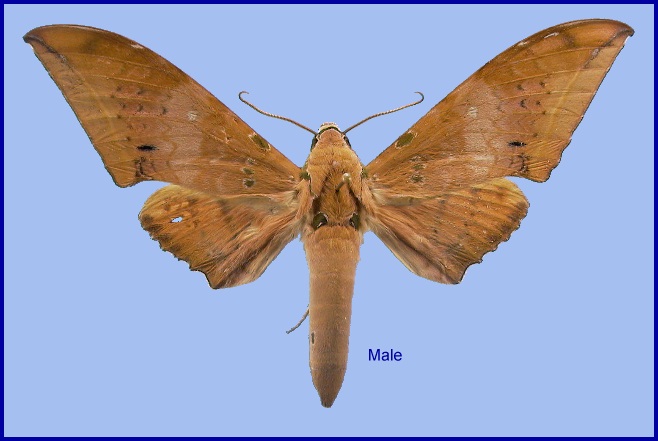
Ambulyx moorei Moore, [1858], in Horsfield & Moore, Cat. Lepid. Ins. Mus. East India Company 1: 266. Type locality: [Indonesia,] Java [Jawa].
Synonym. Smerinthus decolor Schaufuss, 1870.
Synonym. Ambulyx subocellata R. Felder, [1874], in Felder, Felder & Rogenhofer, Reise öst. Fregatte Novara (Zool.) 2 (Abt. 2): pl. 76, fig. 3. Type locality: [Indonesia,] Java [Jawa].
Synonym. Ambulyx turbata Butler, 1875.
Synonym. Ambulyx thwaitesii Moore, 1882.
Synonym. Ambulyx nubila Huwe, 1895.
Synonym. Oxyambulyx moorei chinensis Clark, 1922.
Note. Ambulyx subocellata was synonymized with Ambulyx semifervens by Hampson, 1893, Fauna Brit. India 1: 78. Reinstated as a species by Rothschild & Jordan, 1903, Novit. zool. 9 (suppl.): 194 (key), 206. Synonymized with Ambulyx moorei by Kitching & Spitzer, 1995, Tinea 14: 178. Implicitly reinstated as the senior name by Zhu & Wang 1997, Fauna Sinica Insecta 11: 229. Resynonymized with Ambulyx moorei by Kitching & Cadiou, 2000, Hawkmoths of the world: 38.
Wingspan: 100--110mm. Similar to Ambulyx canescens, but ranging in colour from yellowish-brown through orange-brown to dark purplish red-brown, never greyish. Markings vary considerably. In the male the head is reddish-brown; thorax--amber with blackish lateral patches; abdomen--upperside amber, a blackish green spot edged with white on each side of the segment 6 laterally. Forewing shape and pattern similar to Ambulyx canescens, but upperside ground colour amber with scattered brown scales, basal band comprising one large and separate and three smaller and connected black circular spots, all edged in greyish, medial area greyish-pink, discal spot white, medial area to submarginal area with three zigzag dark brown lines, a deep brown patch near the apex, a white line runs from the apex to tornus, marginal area yellowish-brown; underside--ground colour amber, with dark brown spots and zigzag dotted lines, the line running from the apex to tornus dark brown, marginal area greyish. Hindwing--upperside ground colour amber, a blackbrown line in the medial area and a black-brown zigzag line in the submarginal area, marginal area dark brown, tornal area greyish-yellow; underside--almost the same as the upperside but pattern paler (Jiang, Kitching, Xu, Xu, Yan, Yu, Liu & Hu, 2025).
In the male genitalia, abdominal sternum A8 with posterior margin having a weak mesal lobe; edge of lobe produced internally to two tubercles, which lie close together. Gnathos in the form of two widely separated lobe-like processes inclined towards each other. Harpe extending basally from ventral to dorsal edge of valva; produced into long pointed process, which curves ventrad, and usually bears a tooth at its base; ventrally produced into irregular spatulate process, upper edge produced into a trialngular tooth. Phallus lacking external armature; vesica with ribbon-like sclerite densely covered with minute denticles. In the female genitalia, tergum A8 less sclerotised mesally than laterally. Ostium bursae large with anterior margin folded; laterally, sterigma raised and complex.
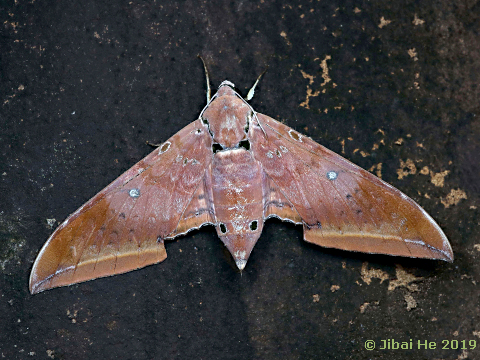
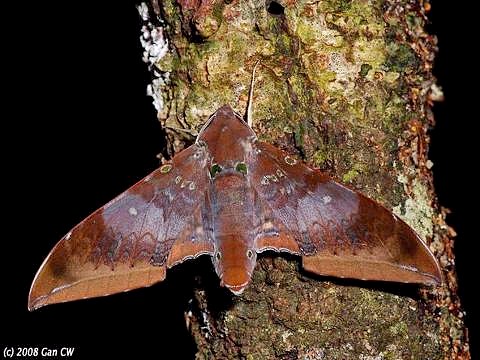
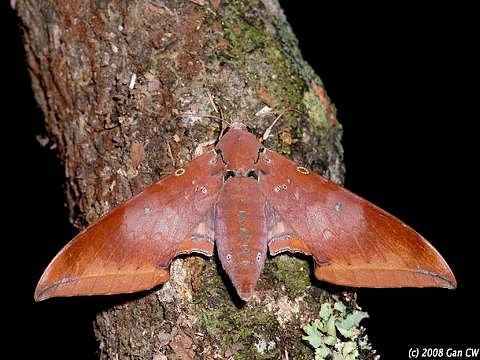
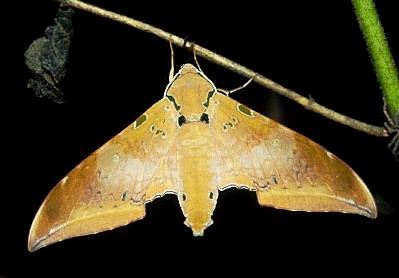
The moths rest in the same position as others of the genus. They are very sluggish during the day and unwilling to move, but fly well at night. Very difficult to pair in captivity (Bell & Scott, 1937).
In the eastern Himalaya in occurs locally in forests with heavy rainfall at 4000' (Bell & Scott, 1937).
China: 2.i (Guangdong); ii (Guangdong); iii (Guangdong); iv (Guangdong; Hong Kong; Yunnan); v (Guangdong; Hong Kong; Hainan); v-vii (Hainan); vi (Guangdong; Hainan); vii (Hong Kong; Yunnan); 1.viii (Hainan); 6-30.viii (Yunnan); 30.ix (Guangxi); x (Hong Kong; Guangdong); 16.xi (Hong Kong); 29.xi (Hainan); 10.xii (Guangdong).
OVUM: Bright grass-green, slightly oval (1.5 x 1.70mm), shiny but minutely pitted (Bell & Scott, 1937).
LARVA: Full-fed 86mm long, 11mm wide; horn 16 mm. According to Bell & Scott (1937), in the final instar very similar to that of A. substrigilis, but body rather more slender and horn longer and thinner. Head triangular, three times as long as broad, vertex rounded, with a low, conical tubercle on apex of each lobe. True clypeus not one-third length of head; false clypeus very narrow, apex acute. Labrum short, slightly broader than long. Ligula open horseshoe-shaped, each side produced into a long arm, length three-quarters that of true clypeus. Eyes arranged as in others of the genus. Surface of head slightly shiny, very obscurely and irregularly transversely wrinkled, covered very sparsely with minute setiferous tubercles. Body dull, with a transverse row of small conical tubercles around each secondary ring, these reaching the dorso-lateral line. There is a dorso-lateral row of larger tubercles from segment 2 to segment 11, with similar large tubercles on the oblique lateral stripes, these extending backwards across the dorsum. Horn set sparsely with large tubercles and closely with small, pointed tubercles.
In colour, head aqueous bluish-green with a narrow, double yellowish dorsal stripe from vertex to apex of clypeus and from vertex to nape. There is also a broader white cheek-stripe separating the face from cheek; tubercles white. Labrum glassy-bluish in colour; ligula reddish-brown; basal segment of antenna green, other segments reddish; mandibles green, tip reddish brown. Body grass-green on dorsum between the dorso-lateral lines of tubercles, the latter yellow or rising from yellow dots, except those of the dorso-lateral line on segments 3 to 5, which are white. Below the dorso-lateral lines the body is paler green, strongly suffused with glaucous and dotted with white. There are seven narrow oblique lateral stripes on segments 5 to 11, that on 11 white and running back to the horn. The others are white with white tubercles on them below the dorso-lateral line of tubercles, and extending backward as a line of yellow tubercles to over the dorsum of each segment behind and then on to the dorso-lateral line, forming crosses of tubercles. A large maroon-coloured spiracular patch is present on segments 3 and 4, and there is a maroon-coloured patch above the dorso-lateral line on the hind margins of segments 4 to 10. That on segment 4 is small, the rest increasing in size to 7, where it runs forward along the whole length of the dorso-lateral line to the front margin and upwards along that margin. There are also maroon-coloured basal patches in front of the prolegs and on the venter of 12. This sometimes spreads across the venter from spiracle to spiracle. Horn green, paler below and with a blackish tip. Legs red with base green; prolegs green; anal flap green edged with orange; claspers bluish, edged with orange. Spiracles oval, flush, bluish, the bluish slightly suffused with pale brown inside the rim, which is a fine dark maroon; the spiracles of segments 2 and 12 larger than the rest (Bell & Scott, 1937).
The resting position is the same as for others of the genus. They do not change colour much before pupation, only becoming duller in shade.

Photos: Larvae of Ambulyx species from China. (A) Ambulyx moorei, Foshan, Guangdong, China; (B) Ambulyx sericeipennis sericeipennis, Hongkong, China; (C) Ambulyx ochracea, Guangzhou, Guangdong, China; (D) Ambulyx kuangtungensis, Guangzhou, Guangdong, China; (E) Ambulyx semiplacida montana, Pingbian County, Yunnan, China; (F) Ambulyx schauffelbergeri, Chongqing City, China; (G) Ambulyx siamensis, Mengla County, Yunnan, China; (H) Ambulyx siamensis, Mengla County, Yunnan, China; (I) Ambulyx liturata, Mt. Maoershan, Guangxi, China; (J) Ambulyx tobii, Kunming, Yunnan, China. (© Jiang, Kitching, Xu, Xu, Yan, Yu, Liu & Hu, 2025)
PUPA: 46--50mm long, 11.5--13mm wide. Similar to that of A. substrigilis, but more slightly built and with sometimes a small coxal piece. Colour dark chestnut except for hind bevels of segments 8 to 10, which are much paler in colour; spiracles black with central slit chestnut cremaster nearly black. Surface shiny, but body, except for the hind bevels of segments 8 to 10, roughened with irregular wrinkles, corrugations and groups of tubercles, nowhere prominent. In addition, the abdominal segments are shallowly pitted; there is a narrow, smooth dorsal line on the thorax; the wing veins are prominent, with wing-cases transversely lined. There is sculpturing on segment 4 consisting of two deep transverse channels on each side, one close to and parallel with front margin and one close to and parallel with the hind margin, having a smooth, raised, flat area between them, the dorsal line carinate. Segment 6 is also dorsally carinate. There are ante-spiracular ridges on segments 9 to 11, those on 9 consisting of very narrow, shiny ridges separated by eight deep, narrow, parallel, smooth channels. There are similar but fewer and shorter ridges on 10 and 11. Spiracle of segment 2 indicated by a lappet on the front margin of 3, with the hind margin of 2 curved marginate and thickened in front of it. Remaining spiracles oval, flat, with a narrow raised slit. Cremaster wedge-shaped, triangular from dorsal view, base broad and undercut, laterally compressed, as high as broad except at tip where it ends in a smooth, low, short ridge dividing into two short diverging teeth; the surface (except for the teeth at tip) very rugose and wrinkled (Bell & Scott, 1937).
Pupation in an ovoid cell about 15cm underground.
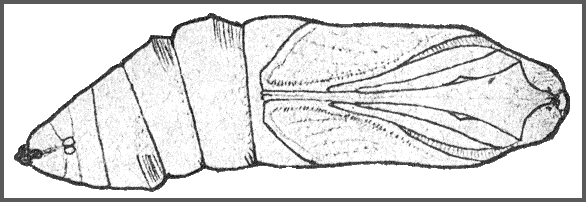

Larval hostplants. Canarium album (Burseraceae) in China, but recorded from various Anacardiaceae in India (Bell & Scott, 1937). In Bhutan on Buchanania, Lannea and Canarium.
China: Yunnan (Jinping; Menglun; Xima, Yingjiang County, 1500m; Mengla County, 847m; Manyong); Xizang/Tibet; Guizhou; Guangdong (Guangzhou; Foshan; Nan'ao; Shenzhen; Jiangpu; Zhuhai; Zhaoqing); Hong Kong (Shek Kong); Guangxi (Longtan; Chongzuo; Hezhou); Hainan (Chengmai; ??Secha; Taiping; Wuzhishan; Jianfengling National Park, Ledong County, 1012m; Tianchi; Baotie; Diaoluoshan National Forest Park; Sanya).
Sri Lanka, southern, eastern and northeastern India (Arunachal Pradesh (Sanjay Sondhi, pers. comm. 2015)), Nepal (Haruta, 1992), Bhutan, Nicobar and Andaman Islands, Myanmar/Burma, Thailand, Laos, Vietnam (Le & Vu, 2024), southern China, Philippines (Palawan, Balabac) (Inoue, 1996), Malaysia (Peninsular, Sarawak), Indonesia (Sumatra, Java, Kalimantan to Timor).

Map: Distribution of assorted species of Ambulyx from China: Ambulyx substrigilis (purple dotted line); Ambulyx siamensis (ochre squares); Ambulyx liturata (blue dotted line); Ambulyx moorei (red dotted line); Ambulyx canescens (green dotted line); Ambulyx ochracea (yellow patch); Ambulyx maculifera (black triangles); and Ambulyx zhejiangensis (pink triangles). (© Jiang, Kitching, Xu, Xu, Yan, Yu, Liu & Hu, 2025).
Oriental.
 Return to Sphingidae of the Eastern Palaearctic species list
Return to Sphingidae of the Eastern Palaearctic species list